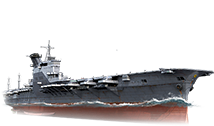PJSA017 Hakuryu 1942
| Revision as of 04:37, 22 September 2015 | Revision as of 10:46, 15 April 2016 | |||
| Line 6: | Line 6: | |||
| '''Pros''' | '''Pros''' | |||
| ? | * | + | * Can put several squadrons into the air at any given time, especially strike aircraft | |
| ? | * | + | * Carrier itself has good concealment values | |
| ? | * | + | * Deck does not burn easily | |
| ? | * | + | * A daunting thing to be wary of in high tier matches | |
| ? | * | + | * Fighters are rather sound at their tier | |
| '''Cons''' | '''Cons''' | |||
| ? | * | + | * Squadron has a small air wing which makes it a bit easy to have fighters intercept them | |
| ? | * | + | * Fighters are still swamped by US fighters in dogfights | |
Revision as of 10:46, 15 April 2016
| kt Max Speed |
| s Rudder Shift Time |
| m Turn Radius |
| - mm Hull Armor |
| - mm Citadel Armor |
| - mm Deck Armor |
| - mm Extremities Armor |
| Guns |
| Guns |
| Torpedoes |
| Recon Squadrons |
| km Aerial Detection Range |
| km Surface Detection Range |
Modules
Compatible Equipment
Player Opinion
Performance
Rightly dubbed as the "Sky Hammer" due to the notion that she can have a lot of squadrons in the air at any given time, the Hakuryu is a battleship's worst nightmare, with special mention to the Yamato which was sunk by aircraft during her very last sortie, as she can field a large number of squadrons, one particular loadout having six strike aircraft at her disposal, to destroy any capital ship or a standard ship in the water. The cost of having a large number of squadrons in the air however is the fact that each squadron has a small air wing than their US counterparts and can be easily destroyed by a very solid AA screen or good fighters that can intercept the planes. The carrier is no slouch when it comes to visibility as being large as she is, she has a rather reasonable concealment value, better than her counterpart the Midway.
Pros
- Can put several squadrons into the air at any given time, especially strike aircraft
- Carrier itself has good concealment values
- Deck does not burn easily
- A daunting thing to be wary of in high tier matches
- Fighters are rather sound at their tier
Cons
- Squadron has a small air wing which makes it a bit easy to have fighters intercept them
- Fighters are still swamped by US fighters in dogfights
Historical Info
| Destroyers | |
| Cruisers | |
| Battleship | |
| Aircraft Carriers |
| USA | |
| UK | |
| USSR | |
| Japan |
